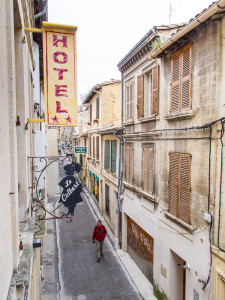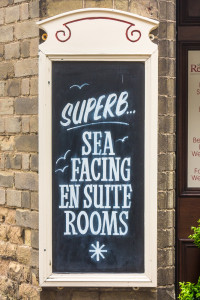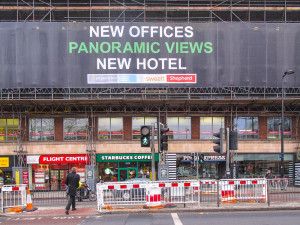Photographing the view from hotel rooms wher I have stayed has been an occasional project over recent years. I think there is now enough material to put into a photo book. The text below will be a short introductory essay.
Inventing a Room with a View
‘The Signora had no business to do it,’ said Miss Bartlett, ‘no business at all. She promised us south rooms with a view, close together, instead of which here are north rooms, here are north rooms, looking into a courtyard, and a long way apart. Oh, Lucy!’….
‘I wanted so to see the Arno. The rooms the Signora promised us in her letter would have looked over the Arno. The Signora had no business to do it at all. Oh, it is a shame.’
‘Any nook does for me,’ Miss Bartlett continued: ‘but it does seem hard that you shouldn’t have a view.’
 So begins E. M. Forster’s 1908 Room with a View and its penetrating study of conflicting values, classes and cultural perspectives, a study in which the ‘view’ is more than what may be seen from a hotel room. While the desire that the Misses Bartlett and Honeychurch express for a room with a view now seems perfectly reasonable, and is a selling point for many hotels, it represents the coming together comparatively recently of a number of social, technological and economic factors.
So begins E. M. Forster’s 1908 Room with a View and its penetrating study of conflicting values, classes and cultural perspectives, a study in which the ‘view’ is more than what may be seen from a hotel room. While the desire that the Misses Bartlett and Honeychurch express for a room with a view now seems perfectly reasonable, and is a selling point for many hotels, it represents the coming together comparatively recently of a number of social, technological and economic factors.
The earliest windows were small, unglazed and served mainly to provide illumination and ventilation, or on occasions an aperture from with to shoot enemies. While the Romans were known to have used glass for windows, it was not until 17th century that glass became at all common in ordinary homes. Even so, the glazing was in small panes of crown glass, which while acceptable for letting in light, had very poor optical qualities for looking through to enjoy the outside view. It was not until 1848 with James Hartley’s invention of cast plate glass that it became possible to install windows to create a room with a comfortable year-round view.
Any concern about the optical quality of earlier windows presupposes that people wanted to look at the view. Taking the cue from art, it is apparent that an appreciation of natural landscape and real townscape is comparatively recent in the broader sweep of history. Ancient Roman and Chinese art typically show grand panoramas of imaginary landscape, usually backed by a range of spectacular mountains and waterfalls or maybe the sea. In western art landscape painting was seen generally as lowly in the hierarchy of genres. The technique for rendering perspective in landscape developed slowly and in the early 15th century landscape in art was shown, if at all, as the setting for human activity. Through into the 17th century landscape was routinely idealised, depicted as a pastoral idyll drawing on classical, mythological and religious themes. Portraits used stylised landscapes as backgrounds.
A significant shift towards an appreciation of landscape emerged in the shape of the Romantic Movement between around 1770 and 1850. The Movement accepted intense emotion – pleasurable awe, horror and apprehension – as a valid source of aesthetic experience, especially when encountered in confronting sublime, untamed nature and its picturesque qualities. Romanticism, as a reaction against the emerging industrial revolution, enshrined a strong belief in the importance of nature. The aesthetic appreciation of landscape was accompanied by the development of increasingly meticulous technique and John Ruskin saw landscape painting as the ‘chief artistic creation of the nineteenth century’.
 The appreciation of townscape, or cityscape, followed a similar evolutionary path. In the Middle Ages cityscapes appeared as backgrounds for portraits and Biblical themes. From the 16th through to the 18th century prints and etchings were made showing a bird’s eye view of towns and cities. Cityscape painting emerged as a separate genre in the Netherlands in the middle of the 17th century with Vermeer a leading exponent; and flourished in 18th century Venice, pre-eminently in the work of Canaletto. While the Romantic Movement may be seen as a reaction to urbanisation and the industrial revolution, 19th century art also depicted the emerging urban realities with a new aesthetic through the work of artists like Frith, Dore, Grimshaw and Maddox Brown. Indeed it is just such a foreground that Lucy Honeychurch enjoys from her window:
The appreciation of townscape, or cityscape, followed a similar evolutionary path. In the Middle Ages cityscapes appeared as backgrounds for portraits and Biblical themes. From the 16th through to the 18th century prints and etchings were made showing a bird’s eye view of towns and cities. Cityscape painting emerged as a separate genre in the Netherlands in the middle of the 17th century with Vermeer a leading exponent; and flourished in 18th century Venice, pre-eminently in the work of Canaletto. While the Romantic Movement may be seen as a reaction to urbanisation and the industrial revolution, 19th century art also depicted the emerging urban realities with a new aesthetic through the work of artists like Frith, Dore, Grimshaw and Maddox Brown. Indeed it is just such a foreground that Lucy Honeychurch enjoys from her window:
‘Over the river men were at work with spades and sieves….on the river was a boat….An electric tram came rushing underneath the window….its platforms were overflowing with Italians….Then soldiers appeared….and before them went little boys, turning somersaults….’
From the 1840s both landscape and townscape were appreciated through photography, the archetypal tourist activity.
But who was to appreciate the view? Early travellers, like traders and pilgrims, had other concerns; and appreciation of the view by those on the Grand Tour was limited to the privileged few. Enter Thomas Cook. In 1841, with an excursion from Leicester to Loughborough, he invented modern tourism and begat the millions of travellers, who wanted a room with a view.
With the rise of this industry came the demand for a new type of accommodation. Early travellers were put up in a variety if establishments, like abbeys, caravanserais and inns, where the orientation of the rooms was usually inward to a courtyard. Hotels in the modern sense began to emerge with the industrial revolution through the first half of the 19th century. These were often created through the conversion of existing buildings. Hotels were found in capital city’s and historic towns, along coasts and by lakes. Services progressed through inside toilets, locks on doors, luggage lifts to private bathrooms, electricity and a la carte menus. Le Grand Hotel Paris, purpose designed by Alfred Armand, opened in 1862; and significantly the exterior facades, with high arched doors and Louis XIV widows, were designed to fit the surroundings of the Opera. In 1869 the Mena House Hotel was opened in an oasis of calm at the foot of the pyramids. The second half of the 19th century saw hotels located and designed to realise the potential of providing rooms with a view.
 In effect, hotels in the second half of the 19th century became the embodiment of the concurrent technical, aesthetic and social changes that facilitated and valued the view as an object of the tourist gaze By the time of Forster’s characters’ visit to Florence their anticipation of a view of the Arno was no idiosyncratic whim, but a reasonable expectation.
In effect, hotels in the second half of the 19th century became the embodiment of the concurrent technical, aesthetic and social changes that facilitated and valued the view as an object of the tourist gaze By the time of Forster’s characters’ visit to Florence their anticipation of a view of the Arno was no idiosyncratic whim, but a reasonable expectation.
The room with a view remains a selling point for hotels. Modest establishments, like the Red Lion in Cromer, promote it; Trip Advisor publishes ’10 hotels with incredible views’; and a construction hoarding in London promised ‘Offices Panoramic Views New Hotel’. With the view comes premium prices – you can expect to pay 40-50% more for a room with a sea view at the Grand Hotel, Brighton.
 The premium reflects supply and demand. Given the choice most guests will want a room with a view, but in many cases the geometry of hotel or the location or both limit the number of rooms with a good view. In practice many hotels will be in places where the windows go back to their old function of providing illumination and the view will have little to commend it. So, in fact the experience for many travellers is not to have ‘a room with a view’ in Foster’s sense. The Arno is replaced by car parks, service yards, back streets, motorways, railway lines, airports, construction sites and unprepossessing neighbours. This album is dedicated not to those who enjoy great hotels with stunning panoramas, but to those who travel hopefully and experience the everyday views of new places and enjoy the passing throng as did Lucy Honeychurch
The premium reflects supply and demand. Given the choice most guests will want a room with a view, but in many cases the geometry of hotel or the location or both limit the number of rooms with a good view. In practice many hotels will be in places where the windows go back to their old function of providing illumination and the view will have little to commend it. So, in fact the experience for many travellers is not to have ‘a room with a view’ in Foster’s sense. The Arno is replaced by car parks, service yards, back streets, motorways, railway lines, airports, construction sites and unprepossessing neighbours. This album is dedicated not to those who enjoy great hotels with stunning panoramas, but to those who travel hopefully and experience the everyday views of new places and enjoy the passing throng as did Lucy Honeychurch
Anyway, what’s in a view? Forster has George Emerson observe:
‘My father’ – he looked up at her (and he was a little flushed) – ‘says that there is only one perfect view – the view of the sky straight over our heads, and that all these views on earth are but bungled copies of it.’
